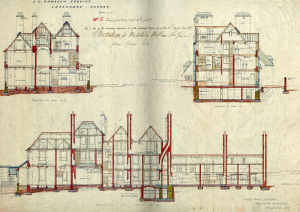 Designing Buildings(DBW) Designing Buildings (DB) – host and partner to the IHBC’s Conservation Wiki –has posted on its open access Wiki service an article tracing the evolution of ‘Architectural Styles’.
Designing Buildings(DBW) Designing Buildings (DB) – host and partner to the IHBC’s Conservation Wiki –has posted on its open access Wiki service an article tracing the evolution of ‘Architectural Styles’.
image for illustration: Lapscombe, Surrey Drawing from Context 174, Dec 2022
… Buildings first evolved from a need for shelter…
DBW writes:
Buildings first evolved from a need for shelter, security, places for worship, places for congregation, and so on. The way that these needs were satisfied using the available materials, space and skills gave rise to a wide range of building techniques and styles.
The origins of human-made shelters can be traced back over 40,000 years to the ice age and the Siberian Steppe, where remains have been found of simple shelters constructed from animal skins draped between sticks. It is likely that structures of this type were the first dwellings constructed by humans. These ‘tented’ structures thrived in regions where materials were scarce, or where survival required mobility; both conditions which tended to be brought about by low rainfall. Changing climates brought about a slow transition from nomadic tents to permanent huts and vice versa, and it was from the resultant process of intermediate modification that an enormous range of composite dwellings evolved.
Some of these basic generic forms of structure are still used in remarkably un-changed forms throughout the world today, for example, the black tent, the mud brick hut, and the yurt (a composite structure still in common use in Mongolia). It was through the maintenance and personalisation of these early structures, that decoration was introduced, and they became more than purely functional shelters. As cultures developed and knowledge was formalised, the process of building became a craft and vernacular ‘architecture’ emerged…
Read more on the development of the designs
See more on the IHBC’s Conservation Wiki

